The AMD Llano Notebook Review: Competing in the Mobile Market
by Jarred Walton & Anand Lal Shimpi on June 14, 2011 12:01 AM ESTApplications, Round Two: Treading Water
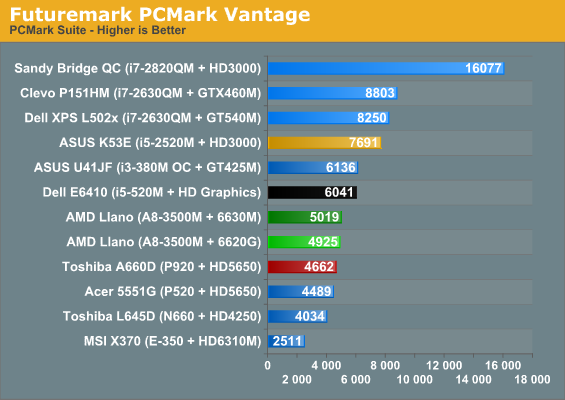
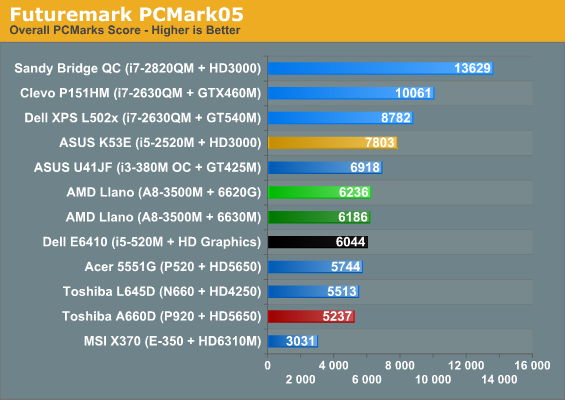
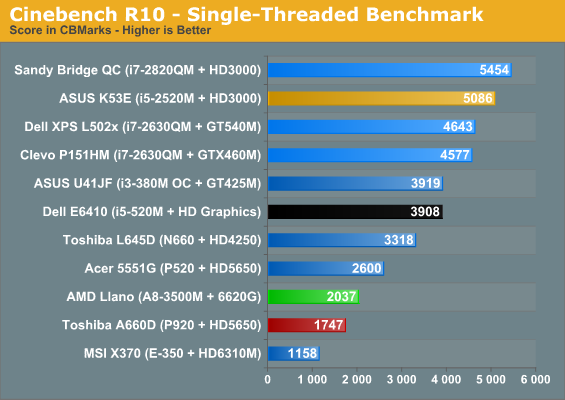

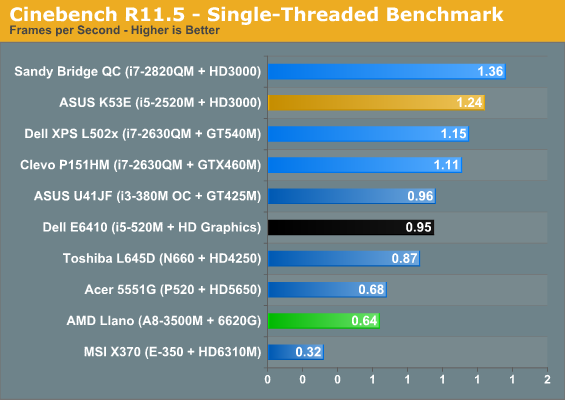
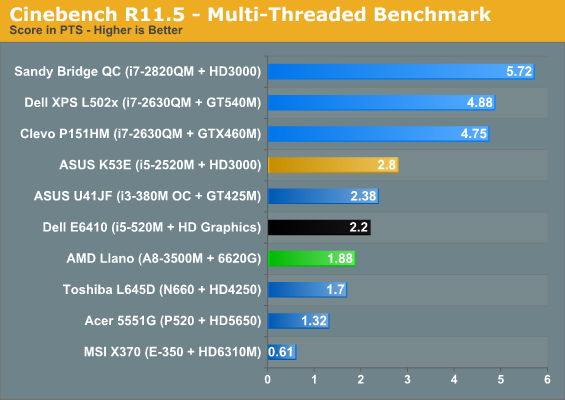
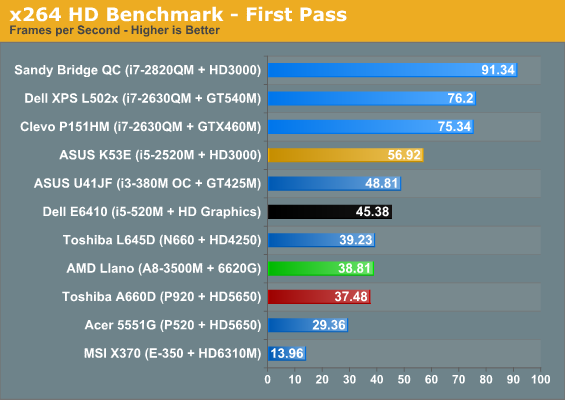
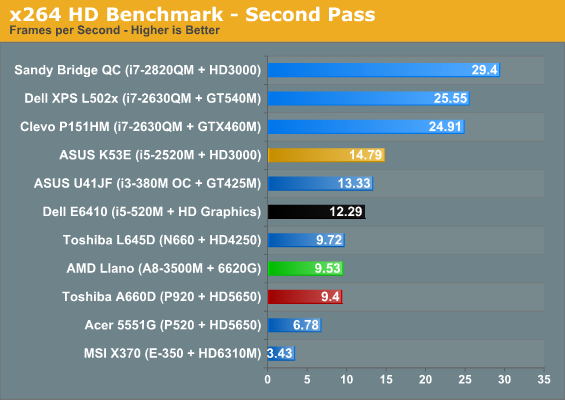
This time we have a more interesting competitor to look at: the Toshiba A660D. AMD says Turbo Core works at speeds of up to 2.4GHz on the A8-3500M, but we have no way of monitoring the actual CPU clocks right now. (CPU-Z if you’re wondering shows a constant 1.5GHz, but AMD says that utility doesn’t currently detect the proper clocks.) When we compare performance results between the Llano notebook and the A660D, we definitely see some differences in performance. Some of that may come from the added L2 cache and other architectural tweaks, but Cinebench R10 in particular shows a healthy 17% performance increase, even with a base clock that’s 7% lower. In the multi-threaded Cinebench result, the lead drops to 10%, which correlates well with how we’d expect Turbo Core to work. PCMark Vantage is still heavily influenced by the storage subsystem, and the storage score of 2950 on the A660D versus 3791 on the Llano suggests the Toshiba HDD is a significant bottleneck.
Looking at other laptops and tests where we’re looking purely at CPU performance, suddenly Llano starts to struggle. The Arrandale i5-520M offers 92% higher single-threaded performance in Cinebench R10 and 48% better single-threaded performance in R11.5; multi-threaded performance also goes to Arrandale, with a 23% lead in R10 and 17% lead in R11.5. x264 also gives Arrandale a decent lead, with i5-520M 17% faster in the first pass and 29% faster in the more intense second pass. The overclocked i3-380M in ASUS’ U41JF tells a similar tale—and both of these laptops are running processors from early last year. When we shift to Sandy Bridge, even without looking at the quad-core parts AMD’s CPU performance is tenuous. The i5-2520M is anywhere from 50 to 150 percent faster depending on which test we look at; even if we toss out the older Cinebench R10 single-threaded result of 150%, R11.5 given the 2520M a 94% lead. In general, then, a moderate dual-core Sandy Bridge i5-series processor looks to be at least 30% faster, so quad-core Llano really only competes with Core i3 and its lower, non-Turbo clocks.
None of the results here are particularly surprising; K10.5 even at 32nm is still largely the same performance. AMD has focused this round up upgrades more on reducing power consumption rather than increasing performance, and that’s a perfectly reasonable approach for a mobile CPU. Most of us probably aren’t doing 3D rendering, CAD/CAM, or unassisted video transcoding on our laptops anyway. It would still be great to see AMD offer up an equivalent to Intel’s Quick Sync; they have the better GPU architecture, but a dedicated decoder like Quick Sync can clearly pay dividends. Outside of that one deficit the reality is that Llano is still plenty fast. Slapping an SSD into Llano will make more of a difference than upgrading an HDD-based Llano laptop to Core i5, so if you’re looking for an inexpensive laptop that can do everything most users need, Llano is very appealing.










177 Comments
View All Comments
Shadowmaster625 - Monday, June 20, 2011 - link
Can you try setting the affinity manually so that it has to use only one core? I notice that even though I'm running only one thread, that thread will jump around to all my available cores, making them all look like they are running at 25%. Maybe by the time AMD's turbo kicks in, the thread is already moved to another core.GullLars - Tuesday, June 14, 2011 - link
Looking forward to the re-test with an SSD.IMHO all machines over $600 meant for general purpose use in 2011 should include at least a 32GB SSD of Indilinx Barefoot performance or better.
My laptop from 2007 with 2,2GHz C2D and a 32GB Vertex (retrofitted in 2009) still wipes the floor with new $800+ laptops with HDD-only for general use.
JarredWalton - Tuesday, June 14, 2011 - link
Having played with a bunch of laptops using 64GB SSDs, they all feel snappier, though of course it doesn't help with gaming frame rates or CPU computations. Still, I have to say that 64GB isn't big enough for me. If you can get a 32GB mSATA SSD and some sort of SSD caching, and then have a main 500GB HDD, that would be the sweet spot. If you're going SSD-only, I need at least 120GB, and for anything that can run games I'd want 240GB. (By the time I install most of the games I'm currently interested in playing on a regular basis, I easily fill up a 120GB drive.)Anyway, I'm swapping in the SSD now and will start testing during the week, with the follow-up article hopefully ready next week. I've got DC SNB, Arrandale, DC Phenom II, E-350, and now Llano for the article. Anything else you want to request before I call it quits? I've still got the XPS L502x and an AMD K625, but I figure the five laptops are a reasonable representation of what's currently out there. (Note that I have currently focused only on IGP equipped laptops.)
Boissez - Tuesday, June 14, 2011 - link
Results with/without DDR3 RAM would be interesting as it seems RAM speed is a bottleneck.Boissez - Tuesday, June 14, 2011 - link
dang... That should have been with/without DDR3 1600 Mhz RAMBrian23 - Tuesday, June 14, 2011 - link
Application compile benchmarks. ;-)Cloudie - Tuesday, June 14, 2011 - link
The battery life has exceeded my expectations although battery life is a low priority for me when buying a laptop. As long as it gets 4 hours or so at idle is fine by me.Both the GPU and CPU performance has disappointed me somewhat but on the plus side I was not aware until now that the APU being tested was a 35W version, I simply assumed it was the fastest 45W one. Hopefully the CPU perfomance will be just that little bit better on the 45W APUs. And OEMs better get out some decent compact systems with this in... I'd say 13-14" chassis will do me just fine.
just4U - Wednesday, June 15, 2011 - link
If they can get this priced out in a $600 laptop with all the bells and whistles... It will sell. Looking locally (and online) decent gaming laptops start out at about $800. Looking at the numbers it's more then acceptable I think. Profit has to be in there though for AMD.. If their not turning an acceptable profit on each chip then... it will be a wash.duploxxx - Wednesday, June 15, 2011 - link
Looking at the recent preview of anandtech on the desktop Liano part and the increased performance from DDR1333 to DDR 1866 i would like to see what it would bring on a Mobile platform. Afterall LIano mobile does support ddr 1600http://www.anandtech.com/show/4448/amd-llano-deskt...
Germanicus - Wednesday, June 15, 2011 - link
1600 MHz DDR3 - lets make this accurate, since Llano can utilize it.Thank you.